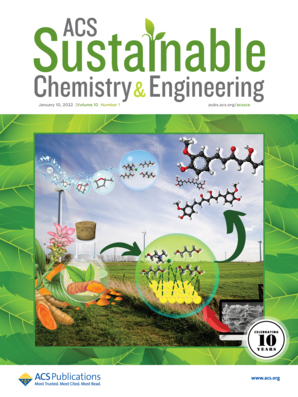High-Strength Binder-less Moldings Prepared by Reassembling Lignocellulosic Biomass Using Formic Acid
IF 7.1
1区 化学
Q1 CHEMISTRY, MULTIDISCIPLINARY
引用次数: 0
Abstract
Lignocellulose is the most abundant renewable bioresource. We developed moldable lignocellulosic biomaterials without utilizing petroleum-derived polymeric resins and adhesives. Meals of Japanese cedar (Cryptomeria japonica), Eucalyptus globulus, and cotton linter were disintegrated by stirring in aqueous formic acid at a mild temperature (50 °C) for 1 week without any catalyst. Thereafter, distilled water was added to the obtained biomass mixture, and the resulting precipitates were collected, washed, and hot-pressed to obtain biomass moldings. The Fourier transform infrared spectra and composition analysis results of the moldings confirmed their formylation. The hydrophobicity test revealed that the contact angles of the water droplets on all of the moldings decreased owing to saponification-induced deformylation, and marked differences were observed in the hydrophobicities of the hardwood and softwood moldings. Further, the contact angle of the hardwood molding decreased much more slowly than those of the softwood moldings with and without saponification. Moreover, the saponification treatment revealed that the formylation of the biomass moldings increased the dimensional stability. Notably, the biomass moldings prepared from E. globulus without deformylation displayed the highest tensile and flexural strengths (43.19 and 86.43 MPa, respectively) as well as a flexural Young’s modulus (6.28 GPa), which was comparable to those of glass fiber-reinforced plastics.

用甲酸重组木质纤维素生物质制备高强度无粘结剂模塑
木质纤维素是最丰富的可再生生物资源。我们在不使用石油衍生的聚合树脂和粘合剂的情况下,开发了可成型的木质纤维素生物材料。在不使用任何催化剂的情况下,将日本雪松(Cryptomeria japonica)、桉树(Eucalyptus globulus)和棉衬垫的碎屑在甲酸水溶液中于温和温度(50 °C)下搅拌 1 周,使其分解。然后,向得到的生物质混合物中加入蒸馏水,收集、洗涤和热压得到生物质成型沉淀。模塑物的傅里叶变换红外光谱和成分分析结果证实了它们的甲酰化。疏水性测试表明,由于皂化引起的变形,所有模塑物上水滴的接触角都减小了,并且观察到硬木和软木模塑物的疏水性存在明显差异。此外,硬木模塑件接触角的下降速度比软木模塑件在皂化和未皂化情况下的下降速度要慢得多。此外,皂化处理显示,生物质模塑的甲酰化提高了尺寸稳定性。值得注意的是,未进行变形处理的球叶桉生物质模塑物显示出最高的拉伸强度和弯曲强度(分别为 43.19 和 86.43 兆帕)以及弯曲杨氏模量(6.28 千兆帕),与玻璃纤维增强塑料相当。
本文章由计算机程序翻译,如有差异,请以英文原文为准。
求助全文
约1分钟内获得全文
求助全文
来源期刊

ACS Sustainable Chemistry & Engineering
CHEMISTRY, MULTIDISCIPLINARY-ENGINEERING, CHEMICAL
CiteScore
13.80
自引率
4.80%
发文量
1470
审稿时长
1.7 months
期刊介绍:
ACS Sustainable Chemistry & Engineering is a prestigious weekly peer-reviewed scientific journal published by the American Chemical Society. Dedicated to advancing the principles of green chemistry and green engineering, it covers a wide array of research topics including green chemistry, green engineering, biomass, alternative energy, and life cycle assessment.
The journal welcomes submissions in various formats, including Letters, Articles, Features, and Perspectives (Reviews), that address the challenges of sustainability in the chemical enterprise and contribute to the advancement of sustainable practices. Join us in shaping the future of sustainable chemistry and engineering.
 求助内容:
求助内容: 应助结果提醒方式:
应助结果提醒方式:


